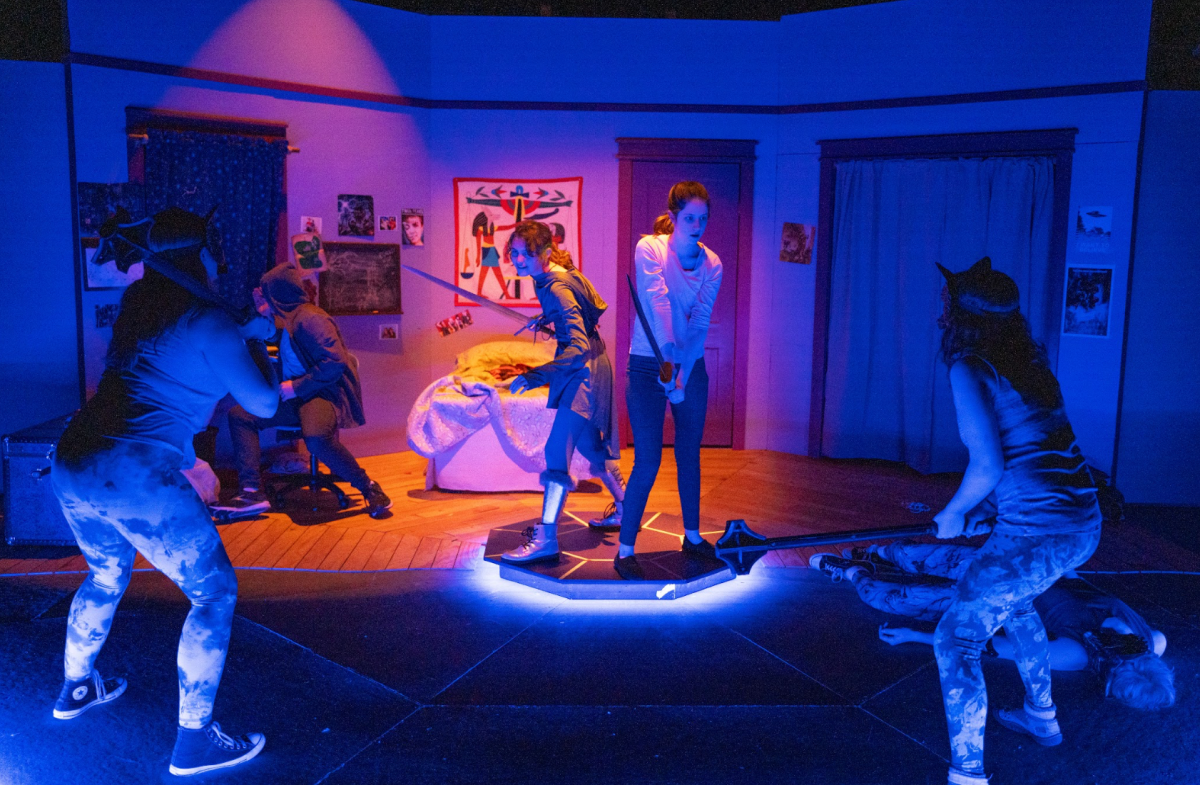The quiet, silver haired IB English teacher floating around campus with an elegant leather briefcase and a crossword puzzle tie seems to always have a destination. Anyone who knows him would tell you a class with Mr. Heilman positively ensures the process of you sauntering into fourth period, pleased with the fleeting analysis of text you were able to smash into your notebook during lunch, only to experience a disheartening blow to your idea within the first five minutes. They would also tell you, though, that this later turns into a profound process of interpretation of eloquent literature that instills within you a dripping desire to read ahead.
English, a class that for most may have been previously associated with grammar and annotating, becomes a wild and curious journey of discovering an author by becoming tediously familiar with their techniques. It doesn’t hurt that every couple of classes, the students manage to swiftly derail Mr. Heilman from his lecture and into a storytelling of his life that tends to be as comical as it is horrifying.
Most of us know his stories about the cousins who tied him to a tree in a forest of snakes and skunks, the lightning strike, or the class that capitalized on his fear of being encroached upon by desks. Generally, these stories begin by accident, because he seems to take in stride the aspects of his life which to us, seem preposterously hard to grasp.
A simple analogy to explain Piggy in ‘Lord of the flies’ may include something along the lines of, “No, no. Piggy is not stupid, but rather, incapable of interpreting and adapting to his surroundings, which causes him to act in ways that make him look stupid. Similarly to when I fell off my roof.” ……What? Obviously we inquire, which results in him leaning back against the white board, crossing his feet, and telling us about the time when the impossible happened.
In case you’ve never encountered the roof story, one fall morning, Mr. Heilman went up to his roof to clean the gutter. Home alone, and scraping the gunk out under the sun, he began to daydream. As things go, he forgot he was on the roof and casually walked right off the roof, a stream of profanities coursing through his thoughts. He landed on his porch, belly up, and lost consciousness.
He proceeded to wake up a few hours later, “I thought I was dead. I wondered if I was a ghost, but then I got up.” He rubbed his sore back, walked into his house and took a shower, telling his wife, with a laugh, once she got home, what had happened while she was gone. She convinced their large and threatening neighbor to urge Mr. Heilman to the hospital or else. It turns out he had seriously injured himself, diagnosed with three snapped ribs and a punctured lung.
This is about the part in the story where people stop laughing and the class resumes. But it actually continues and takes an unexpected turn when Heilman began his recovery. The pain he felt in his abdomen seldom subsided, and increased tremendously when it was time for him to sleep, since he was undistracted from it. As a result, he slept in bursts of two or three hours at a time, and spent his time awake discovering and playing a variety of video, board and puzzle games that filled him with that uniquely solitary midnight glee.
It was in these dark hours when he discovered crossword puzzles. “I became infinitely more intrigued by the process of making a puzzle than the process of solving one” he said, which sounds awfully familiar as it’s exactly parallel to how he teaches us to approach stories, poems and novels. Only by focusing your attention on the device, and why the author put that there and how the author created that effect, can you truly understand the complexities behind a work. “I certainly see how I teach in why I was attracted to crossword puzzles,” Heilman notes. “In class, making lovely, insightful observations is never enough. You must push yourself to discover the trigger of the effect. There’s no great understanding of a puzzle unless you’re a constructor.”
He began to research books and tutorials on how to build a crossword puzzle. Having done some research of my own, I want to stress that this is not the 12 down: head shoulders knees and ___? that you find on the kids menu in your comfy downtown restaurant.
Complex crossword puzzles published by the New York Times, LA Times, and so on are, on a certain level, works of art. They require, from the maker, a mastery of vocabulary, and a level of understanding of how it is that people think and read letters and numerical orders. “The New York times is the “Gold Standard” of publishing a crossword puzzle”, says the English teacher. Heilman began writing and experimenting with this, studying and learning the symmetry and science of the puzzles.
His mother based his motivation to succeed on the simple fact that “Tom always wanted to know how things worked. He likes to excel, and do things right.” Nonetheless, he began to send out his finished works, some of which took him months to finish, and received rejection after rejection from various newspapers. “School was something that always came very easily to Tom”, his mother recalls. Somehow, though, there seemed to be more to getting published than simply writing a good puzzle.
He had reached a point in at which he had two choices, because he had gone “ as far as [he] could go on [his] own… ‘I could drop it, and be content with having learned to make them. Or I could give it another push,’” aka, ask for help from an experienced, published puzzle maker. His choice to proceed with the latter is something that Heilman truly considers a defining moment in his life.
“So many times in life, people believe that they can’t go any farther. That they’ve reached their limit, and it’s time to move on. But oftentimes that moment is just the beginning of the next level.”
When he reached out to a woman whose puzzles he’d grown to admire, she agreed to mentor him so that he could improve his craft. This may have felt to him as though he was compromising his independence; “Tom liked to be on his own, and figure things out for himself.” However, his will to succeed led him to something that eventually opened up a whole new realm of tricks of the trade that he didn’t even know he had to learn.
As of today, Heilman has published over 30 puzzles in the New York Times, LA Times, and a few books. The notion that his journey was not over when he had pushed himself to his limit is one that he considers a crucial lesson. He believes “rigor” is a descriptor for a way of approaching a challenge that people should incorporate into all aspects of life. He believes, for instance, that WIS students often underestimate their academic potential. He recognizes that the volume of the IB workload alone may inhibit students’ abilities to avoid set the expectation at the completion of the task.
But he stands by his belief that students should strive for excellence, an expectation he holds himself to, and therefore, holds his students to. “It’s not about the grades. It’s about developing the skill.” He is arguably the hardest teacher at wis to please, but this motivates his students to do better. However, it’s more inspiring to think your schoolwork has direct payoff on your ability to interpret and analyze your surroundings. It’s more empowering to believe that you are becoming the constructor of your own puzzle.
By Val Deshler

































































